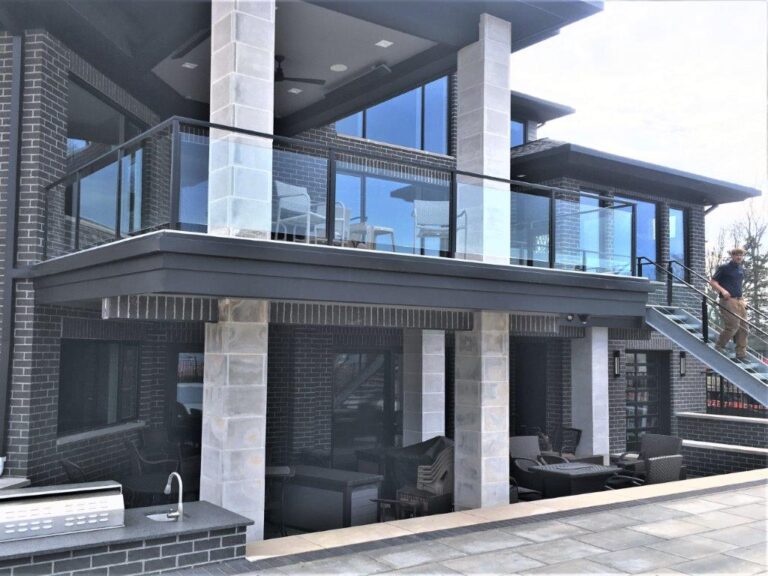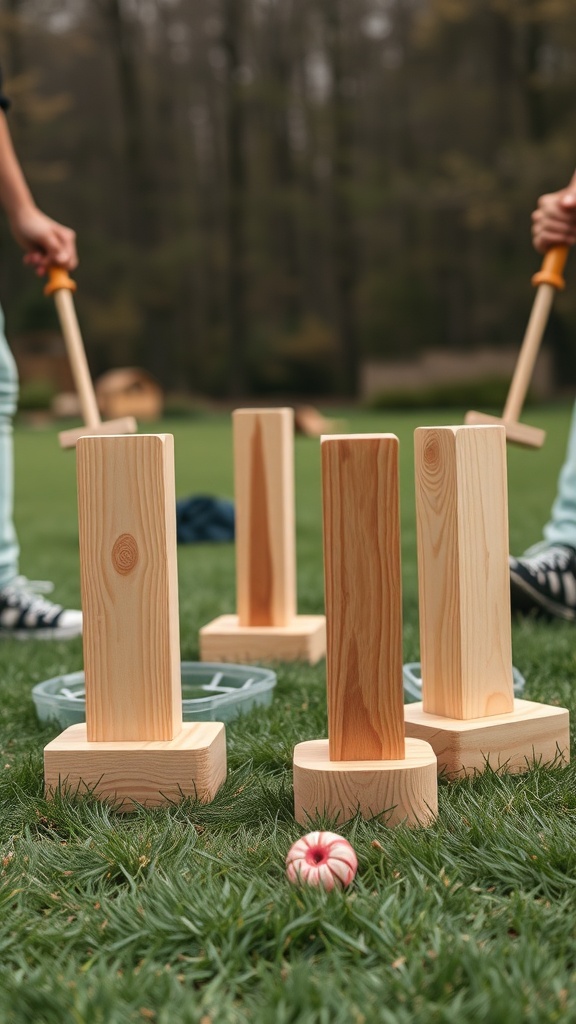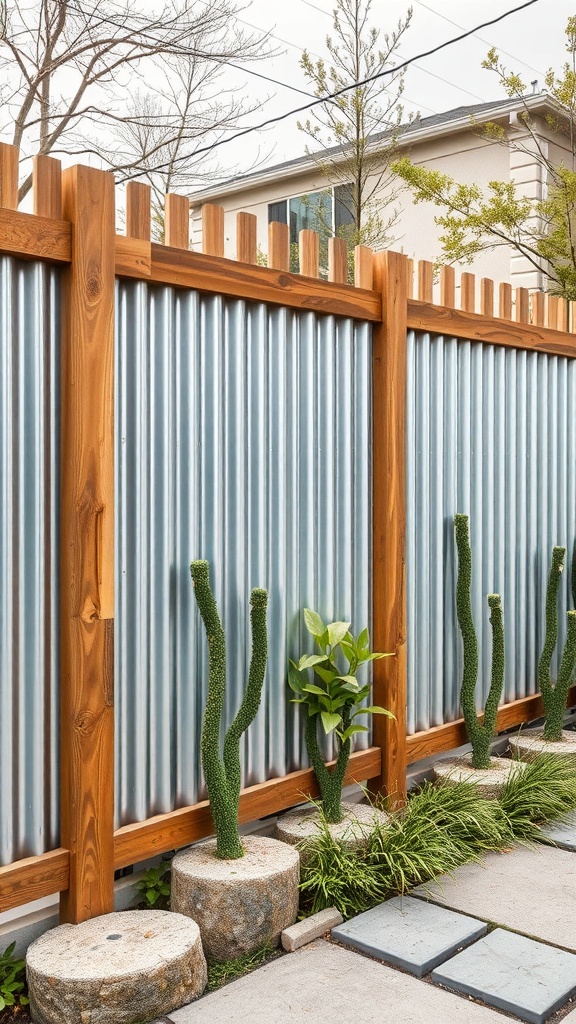31 Creative Side of House Landscaping Ideas to Enhance Curb Appeal
Side of house landscaping can make a big difference in the look and feel of your outdoor space. From simple plantings to creative pathways, there are plenty of ways to transform that often-overlooked area into something beautiful and functional. Let’s explore some ideas to give your home’s side a fresh and inviting upgrade!
Creating a Cozy Outdoor Seating Area

Transforming the side of your house into a cozy outdoor seating area can be a delightful project. The image shows a charming space filled with greenery and inviting seating. The warm glow from the hanging lights adds a welcoming touch, perfect for evening gatherings.
In this setup, comfortable chairs surround a small table, creating an ideal spot for sipping coffee or enjoying a good book. The surrounding plants not only enhance the beauty but also provide a sense of privacy. You can easily replicate this vibe by choosing your favorite plants and arranging them around your seating.
Consider adding some soft cushions to the chairs for extra comfort. A few decorative elements, like candles or small sculptures, can also personalize the space. This area can become your go-to spot for relaxation or entertaining friends.
Incorporating Lighting for Evening Ambiance
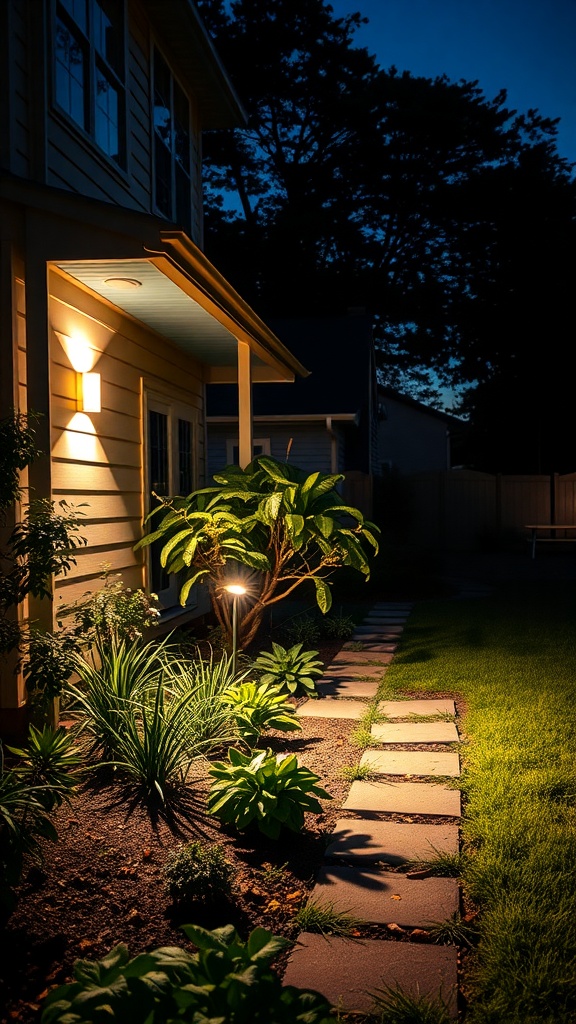
Lighting can completely change the vibe of your side yard. In the image, you see a cozy setup where soft lights illuminate the pathway and plants. This creates a welcoming atmosphere as night falls.
Using lights along the walkway not only guides guests but also highlights the beauty of your landscaping. The plants are gently lit, showcasing their textures and colors. This makes the space feel alive, even after sunset.
Consider adding different types of lights. Spotlights can focus on specific plants, while softer lights can wash over larger areas. This mix adds depth and interest to your outdoor space. It’s a simple way to enhance the overall look of your home.
Don’t forget about safety! Well-placed lighting helps prevent trips and falls, making your yard enjoyable for everyone. Plus, it adds a touch of charm that can make evening gatherings even more special.
Using Decorative Stones for Visual Interest
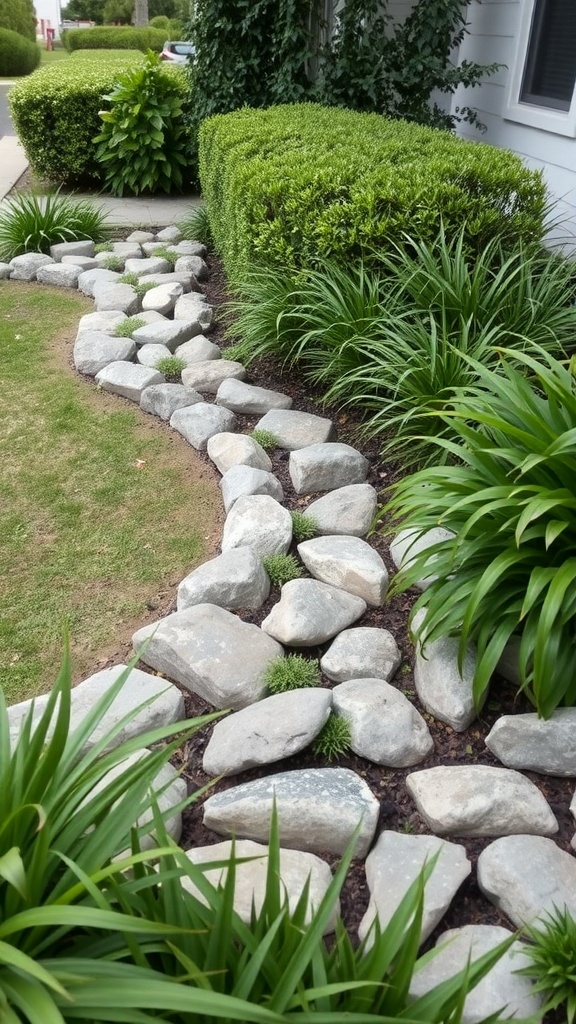
Decorative stones can really jazz up the side of your house. In the image, you can see a lovely pathway made of smooth stones that adds a natural touch to the landscaping. The stones create a gentle curve, guiding the eye along the path and making the area feel inviting.
These stones not only look great but also serve a purpose. They help with drainage and keep the soil in place, which is especially useful in garden beds. The contrast between the stones and the lush green plants adds depth and texture to the landscape.
Incorporating stones into your garden design is a simple way to enhance visual interest. You can mix different sizes and colors to create a unique look. Plus, they require little maintenance, making them a practical choice for busy homeowners.
Incorporating Native Plants for Sustainability

When thinking about landscaping the side of your house, native plants are a fantastic choice. They thrive in local conditions and require less water and maintenance. In the image, you can see a vibrant mix of native plants that not only look great but also support local wildlife.
The tall, feathery plants add texture and height, while the colorful flowers bring a cheerful pop to the garden. This combination creates an inviting space that enhances the overall look of the house. Plus, native plants are adapted to the local climate, making them resilient against pests and diseases.
Using native plants helps create a sustainable landscape. They require fewer resources, which is better for the environment. You’ll also find that they attract beneficial insects and birds, contributing to a healthy ecosystem right in your backyard. So, when planning your side yard, consider these beautiful, low-maintenance options!
Adding a Water Feature for Tranquility
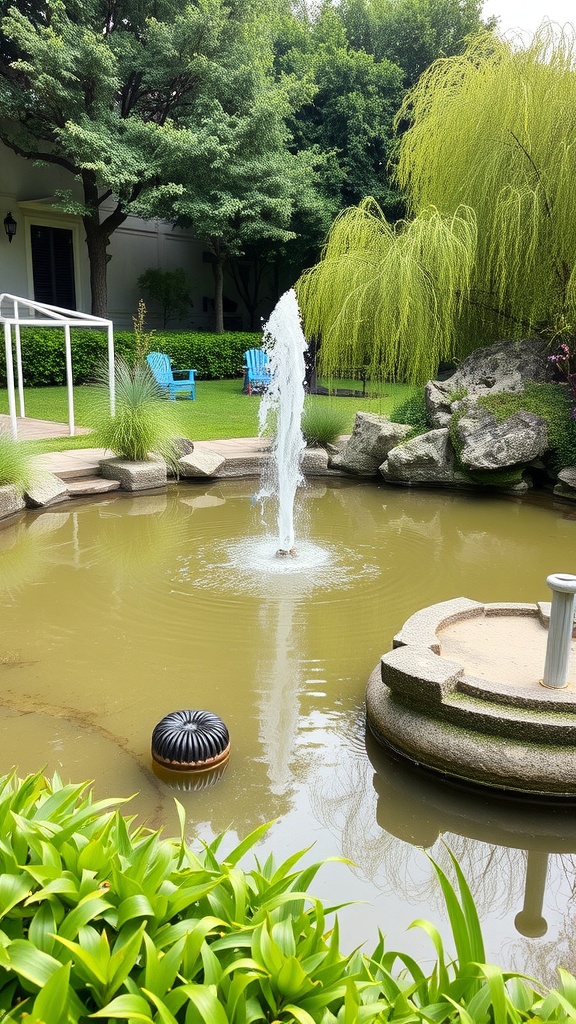
Water features can transform the side of your house into a peaceful retreat. The image shows a lovely pond with a fountain, surrounded by lush greenery and smooth stones. This setup creates a serene atmosphere, perfect for relaxation.
The gentle sound of flowing water can drown out noise from the outside world. It invites you to sit back and enjoy the moment. Imagine sipping your morning coffee while listening to the soothing splash of the fountain.
Adding a water feature like this can also attract wildlife. Birds and butterflies are drawn to water, adding life to your garden. Plus, it can be a great focal point for your landscaping, enhancing the overall look of your outdoor space.
Consider the size and style of your water feature. A small fountain might fit perfectly in a cozy corner, while a larger pond can become a stunning centerpiece. Whatever you choose, it will surely bring a touch of tranquility to your home.
Utilizing Raised Garden Beds for Vegetables
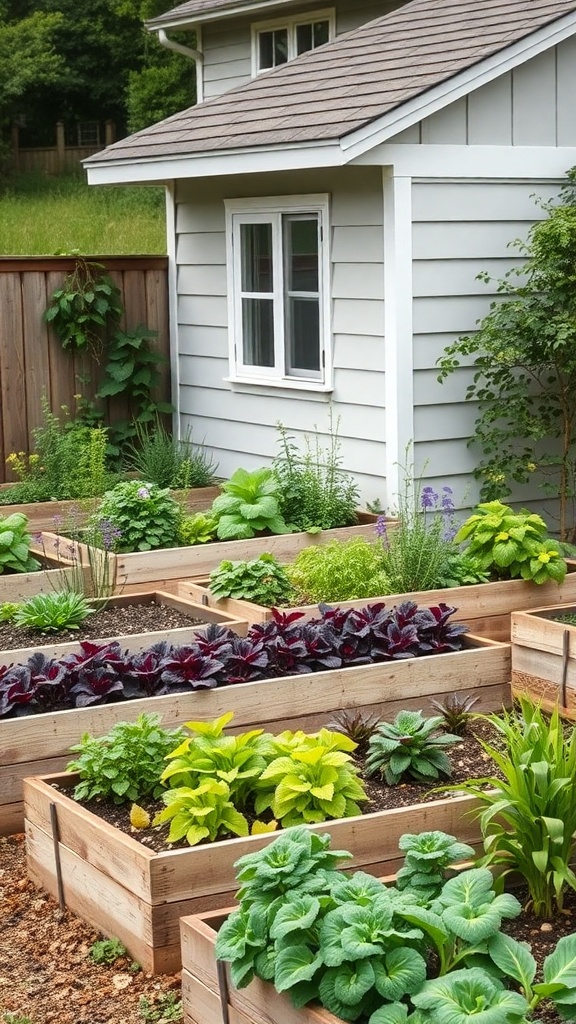
Raised garden beds are a fantastic way to grow vegetables right next to your home. They not only look great but also make gardening easier. The image shows a charming setup with several wooden raised beds filled with vibrant greens and colorful veggies.
These beds provide excellent drainage and soil quality. You can control the soil mix, ensuring your plants get the nutrients they need. Plus, the height of the beds makes it easier to tend to your plants without bending over too much.
In the image, you can see a variety of leafy greens and herbs thriving in their designated spaces. This setup not only maximizes your planting area but also adds a lovely touch to the side of the house. Imagine stepping outside to pick fresh lettuce or herbs for your meals!
Raised beds can be customized to fit your space and style. You can choose different materials for the frames, like wood or stone, to match your home’s look. They can also be arranged in various patterns to create an inviting garden layout.
Overall, raised garden beds are a practical and attractive option for growing your own vegetables. They make gardening accessible and enjoyable, right at your doorstep.
Creating a Lush Garden Pathway

A beautiful garden pathway can transform the side of your house into a welcoming space. Imagine stepping onto a path lined with vibrant flowers and lush greenery. This image captures that essence perfectly.
The stone pathway meanders through a colorful garden, inviting you to explore. Bright tulips, cheerful daisies, and delicate lavender create a stunning visual. The greenery surrounding the path adds a refreshing touch, making the space feel alive.
At the end of the path, a cozy bench sits under a leafy arbor. This spot is perfect for relaxing and enjoying the beauty of your garden. The combination of flowers and greenery not only enhances the look but also attracts butterflies and bees, adding life to your outdoor space.
Creating a lush garden pathway like this one involves choosing the right plants and materials. Use stones or pavers to form the path, and surround it with colorful flowers. Consider adding a seating area for a touch of comfort. With a little planning, you can turn the side of your house into a delightful garden retreat.
Installing a Privacy Fence with Climbing Vines
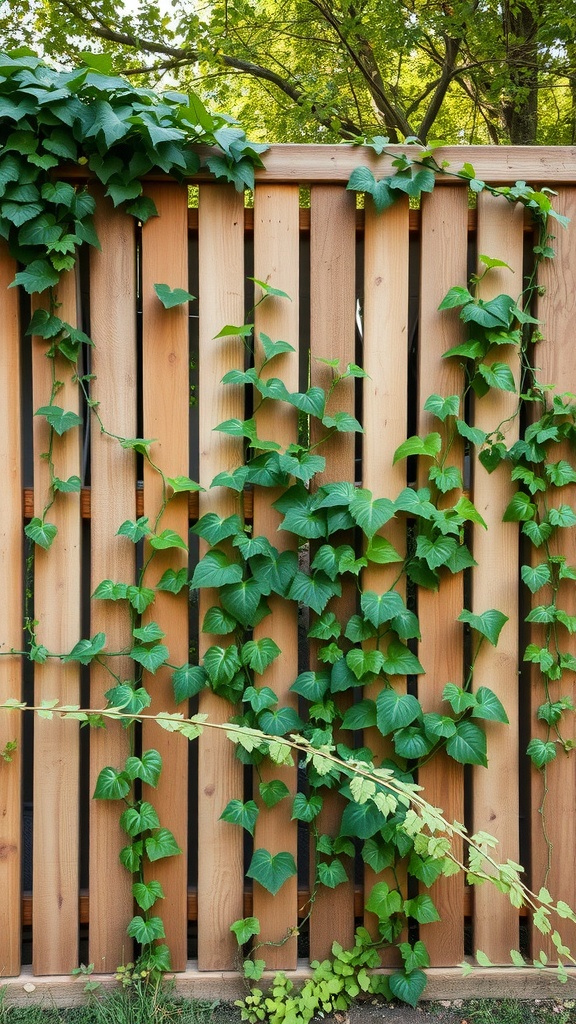
Creating a cozy space in your yard can start with a simple privacy fence. The image shows a wooden fence adorned with climbing vines, which adds a touch of nature to an otherwise plain structure.
These vines not only provide privacy but also enhance the overall look of your yard. As they grow, they can create a lush green wall that feels inviting and serene. Choosing the right type of vine is key; some are fast-growing and can cover the fence quickly.
When installing your fence, consider the spacing between the slats. This allows the vines to weave through and establish themselves. Regular maintenance, like trimming and watering, will keep your climbing plants healthy and thriving.
Incorporating climbing vines with your fence is a great way to blend functionality with beauty. It transforms a simple boundary into a vibrant part of your landscape.
Designing a Herb Garden for Culinary Use
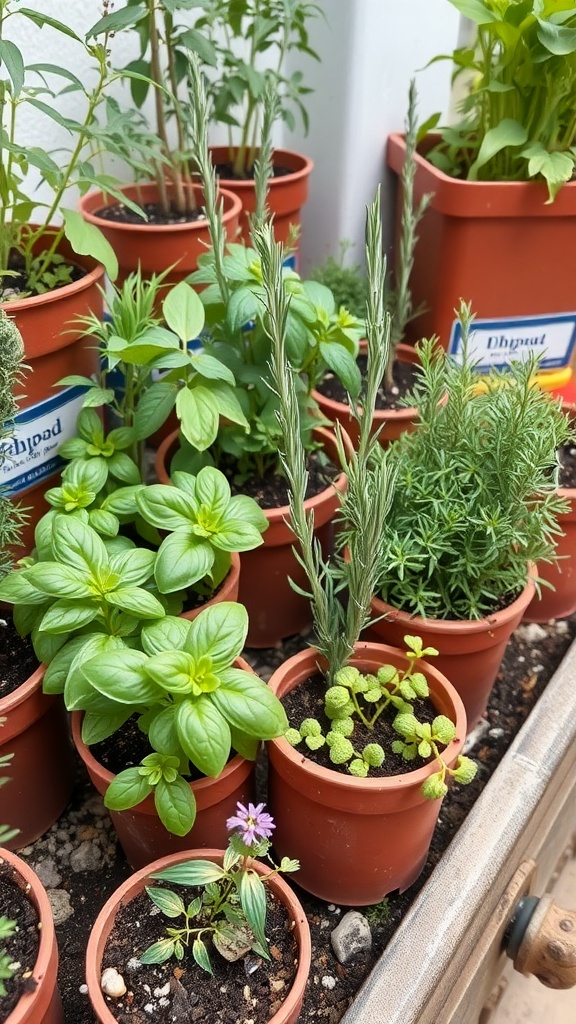
Creating a herb garden is a fantastic way to add fresh flavors to your meals. The image shows a variety of herbs in pots, ready to be used in the kitchen. Each plant offers unique tastes and aromas that can elevate your cooking.
In the picture, you can spot basil, rosemary, and thyme, among others. These herbs are easy to grow and thrive in small spaces. They can be planted in pots, making them perfect for a side yard or balcony.
When designing your herb garden, think about the herbs you use most often. Basil is great for sauces and salads, while rosemary adds depth to roasted dishes. Planting a mix ensures you have fresh herbs on hand whenever you need them.
Don’t forget to consider sunlight and watering needs. Most herbs prefer full sun and well-drained soil. Regular trimming encourages growth and keeps your plants healthy.
With a little care, your herb garden will flourish, providing you with fresh ingredients for your culinary creations. Enjoy the process and the delicious results!
Planting Perennials for Year-Round Color
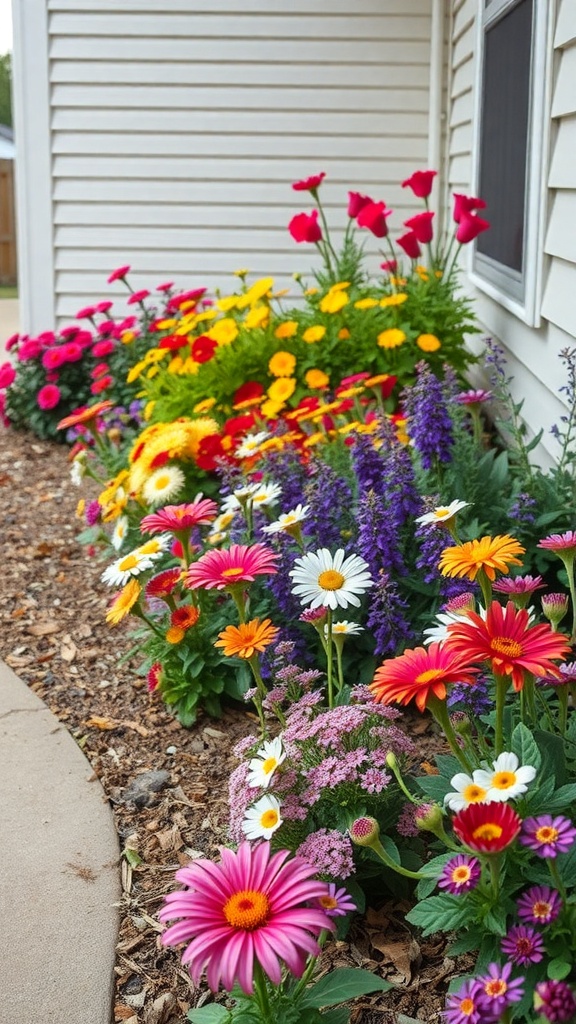
When it comes to side yard landscaping, planting perennials is a fantastic way to add color and life throughout the seasons. The image shows a vibrant display of flowers, showcasing a mix of reds, yellows, and purples. This variety not only brightens up the space but also attracts pollinators like bees and butterflies.
Perennials are a great choice because they come back year after year. This means less work for you in the long run! In the image, you can see daisies, gerbera daisies, and other colorful blooms that create a cheerful atmosphere. Choosing plants that bloom at different times ensures that your garden remains lively from spring through fall.
Consider mixing taller plants, like the purple flowers in the back, with shorter ones in the front for depth. The layout in the image is a perfect example of how to create layers in your garden. This not only makes it visually appealing but also helps with plant health by allowing air circulation.
Don’t forget about soil and sunlight needs when selecting your perennials. Some flowers thrive in full sun, while others prefer partial shade. The right conditions will help your garden flourish and keep those colors popping!
Incorporating Edible Landscaping Elements
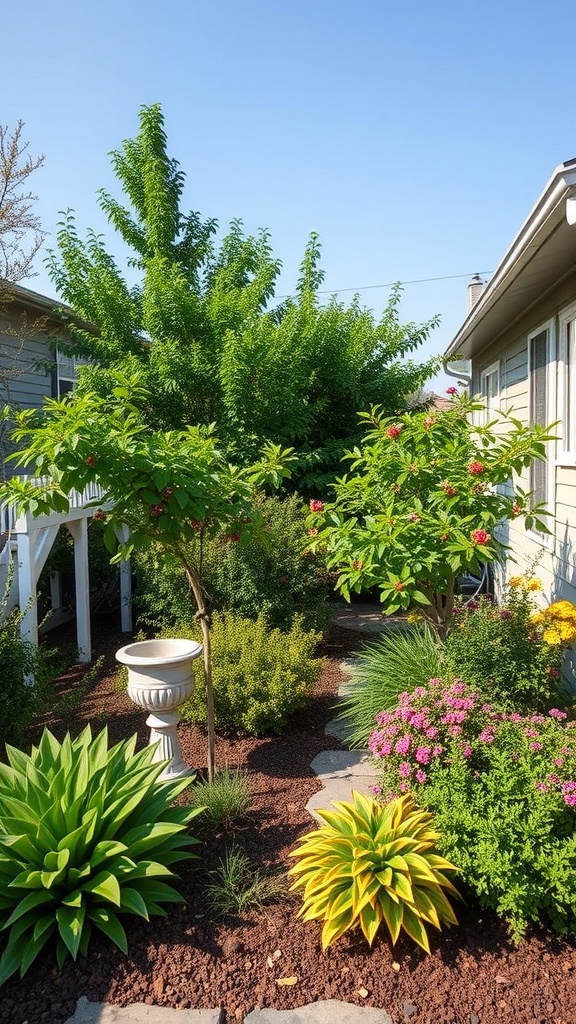
Imagine stepping into a side yard that not only looks great but also offers fresh treats. This image showcases a vibrant landscape filled with greenery and colorful plants. The trees and shrubs create a lush environment, perfect for adding edible elements.
Consider planting fruit-bearing trees like dwarf varieties of apple or cherry. They can fit nicely in smaller spaces while providing delicious snacks. The bright red berries on the trees in the image hint at the possibility of incorporating edible plants that attract both beauty and flavor.
Herbs are another fantastic option. They can thrive in smaller areas and add a burst of flavor to your meals. Think about planting basil, rosemary, or thyme among the colorful flowers. Not only do they look great, but they also offer fresh ingredients right outside your door.
Using edible plants in your landscaping can create a beautiful and functional space. It’s a wonderful way to enjoy nature while also enjoying the fruits of your labor. So, why not mix beauty with practicality in your side yard?
Creating a Rock Garden for Low Maintenance
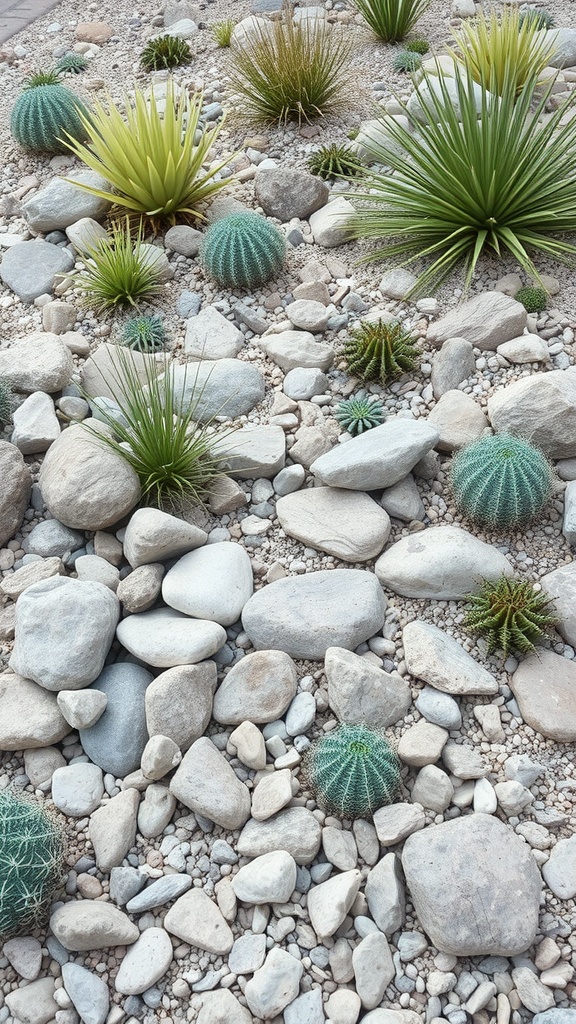
A rock garden can be a fantastic addition to the side of your house. It offers a unique aesthetic while requiring minimal upkeep. The image shows a beautiful arrangement of various rocks and plants, creating a natural look that blends well with the environment.
Using stones of different sizes adds texture and interest. The plants, like cacti and succulents, thrive in dry conditions, making them perfect for low-maintenance landscaping. These plants need little water and care, allowing you to enjoy your garden without constant attention.
When planning your rock garden, consider the layout. Grouping plants in clusters can create a more cohesive look. Mixing in larger stones with smaller pebbles can also enhance the visual appeal. This design not only looks great but also helps with drainage, preventing water from pooling around the plants.
Incorporating a variety of plants adds depth. Choose different shapes and colors to create contrast. The green hues of the plants against the neutral tones of the rocks create a calming effect. This setup is not just practical; it’s also a lovely way to enhance your home’s exterior.
Creating a Natural Border with Hedges

Hedges can be a fantastic way to create a natural border around your home. In the image, you can see a neatly trimmed hedge that adds a touch of greenery to the side of the house. This type of landscaping not only enhances the look of your property but also provides privacy and defines your outdoor space.
Choosing the right type of hedge is key. Some popular options include boxwood, privet, and holly. These plants are easy to maintain and can be shaped to fit your desired look. The hedge in the image appears healthy and well-kept, showing how a little care can go a long way.
When planting your hedge, consider the height and width it will grow to. You want it to complement your home without overwhelming it. The brick border seen in the image helps to keep the hedge contained and adds a nice contrast to the green foliage.
Regular trimming will keep your hedge looking sharp. It’s a simple task that can be done a few times a year. A well-maintained hedge can truly elevate the overall appearance of your home and create a welcoming atmosphere.
Designing a Pathway with Pavers and Grass
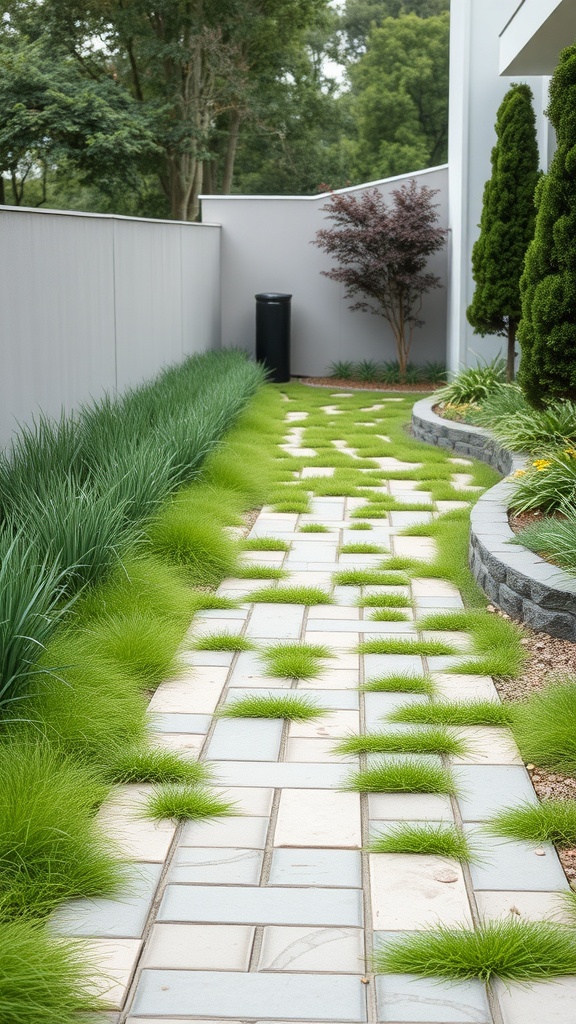
Creating a pathway with pavers and grass can really enhance the side of your house. The image shows a beautiful blend of stone pavers and lush green grass. This combination not only looks inviting but also serves a practical purpose.
The pavers create a defined path, guiding visitors through the space. They are easy to walk on and can withstand various weather conditions. The grass growing between the pavers adds a touch of nature, softening the hard surfaces and making the area feel more alive.
Incorporating grass into your pathway design can also help with drainage. It allows water to seep into the ground rather than pooling on the surface. This is especially useful in areas with heavy rainfall.
When planning your pathway, consider the layout. A winding path can create a more relaxed feel, while a straight path offers a more formal look. You can mix different sizes and shapes of pavers for added interest.
Don’t forget about the surrounding plants! Adding shrubs or flowers along the edges can enhance the overall appearance and create a welcoming atmosphere.
Utilizing Vertical Gardening Techniques

Vertical gardening is a fantastic way to make the most of limited space, especially on the side of your house. The image shows a vibrant wall covered with a variety of flowers and greenery. This colorful display not only beautifies the area but also adds a unique touch to your home.
Using vertical gardening techniques allows you to create a lush, green environment without taking up much ground space. The arrangement of flowers in different colors and shapes creates a stunning visual effect. You can mix and match plants to suit your style, whether you prefer bold colors or soft pastels.
Consider using trellises or wall-mounted planters to support your plants. This setup makes it easy to maintain and can be adjusted as your plants grow. Plus, it’s a great way to bring nature closer to your living space.
Don’t forget to choose plants that thrive in your climate. Some flowers need more sunlight, while others prefer shade. With a little planning, you can create a thriving vertical garden that enhances your home’s exterior.

